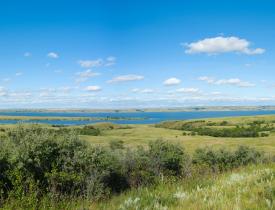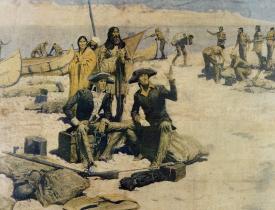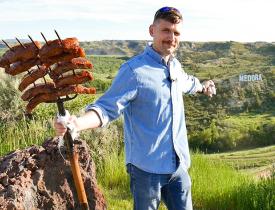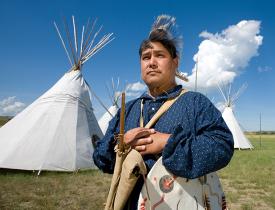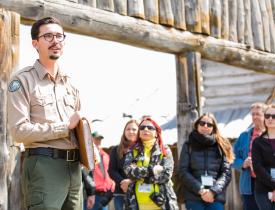North Dakota History
Native American, agricultural and ranching roots run deep in North Dakota.
In North Dakota, history is only as old as yesterday's birding adventure or Badland's trail ride. Reach back to the Jurassic Period or into Lewis & Clark's exploration of the West and discover the stories of great leaders like Sitting Bull and Theodore Roosevelt. In North Dakota, you make legendary history.
First People & Major Immigrant Cultures
First People
The first people in North Dakota were big-game hunters who came to the area after the retreat of the glaciers around 10,000 B.C. The people hunted animals like wooly mammoths and giant bison. Hunter-gatherer and agriculture societies have existed here since 2,000 B.C.
Later civilizations were split between two methods of survival: nomadic groups dependent upon bison and agricultural societies that did some hunting. Nomadic groups consisted of tribes like the Dakota, Assiniboine and Cheyenne, and were greatly influenced by the arrival of the horse to the Northern Plains. Agricultural societies included the Mandan, Hidatsa and Arikara tribes, which were permanent residents whose villages served as major trading centers.
From 1905 to 1920, the population of North Dakota increased from 190,983 to 646,872. The two largest groups were Scandinavians and Germans from Russia, with people of English and Celtic background making up another substantial group.
Scandinavian
Immigrants came to North Dakota from Norway, Sweden, Denmark and Finland. Most settled in east and north-central North Dakota, along the main line of the Great Northern Railroad, beginning in the 1870s. Today, 193,000 people of Norwegian heritage live in North Dakota. About 38% of the state's population is of Scandinavian descent, with about 33% being Norwegian. The continent's largest Scandinavian event, Norsk Hostfest, is celebrated each fall in Minot.
German
Many people of German descent came from Russia in the 1880s and settled in south-central North Dakota. Many left for a variety of political and social reasons, with half of the German immigrants coming from Russia and the other half coming directly from Germany to the United States. The land they settled on was semi-arid and similar to that of the steppe in Russia and they used it for pasture and to grow small-grain crops, living in sod houses, similar to "semeljankas" in Russia. North Dakotans from German or Germans from Russia descent total about 43%.
English or Celtic
Most immigrants to North Dakota from England, Ireland, Scotland and Wales went first to Canada, then to the United States. Currently, about 7% of the state's population is of Irish descent. Many settlers came to North Dakota from Selkirk Colony, which was established in Canada by Britain. They generally settled in the northeast corner of the state. Many of North Dakota's early leaders came from this group, including John Miller, the state's first governor.
Pioneer Heritage
From wherever they came, North Dakota’s first European settlers had much in common. Following is a list of attractions and events where you can turn back the clock to see how they lived and carved out a life on the prairie.
- Bonanzaville - The sprawling Bonanzaville in West Fargo showcases farm machinery demonstrations and other “living history” year-round, including the main event, Pioneer Days, a weekend filled with pioneer demonstrations of threshing, rug making, butter churning, wood carving, blacksmithing and much more.
- Bagg Bonanza Farm - One of the last remaining, largely intact farms from the bonanza farming era, as dramatized by Steinbeck in "Of Mice and Men."
- Pioneer Villages - Many towns across the state have created replicas of their early history by preserving and moving old building to create a “walk-through” museum, many of which house the main museum properties of the local historical society. To name a few, check out Jamestown’s Frontier Village, Bismarck’s Buckstop Junction, Fort Ransom's Sunne Farm or Rugby's Prairie Village.
North Dakota Industry History
Fur Trade
Fur trade in what is now North Dakota led to the first interaction between American Indians and Europeans. The most popular furs for trade were buffalo hides and beaver pelts. The first white man in North Dakota was Pierre de La Verendrye, who visited the Mandan tribe on behalf of a trading company. The first trading post in North Dakota was established in 1801 at Pembina by Alexander Henry. Trading posts were established at Fort Union near present-day Williston and Fort Clark near Washburn to further enhance trade with American Indians or Metis trappers and hunters. Metis were children of marriages between European traders and American Indians. They were widely known for their trading skills and actively participated in the oxcart trade between eastern North Dakota and St. Paul, Minn.
North Dakota Agriculture
Agriculture has been important to the people of North Dakota since they arrived in this area thousands of years ago, and remains North Dakota's largest industry today. The Mandan, Hidatsa and Arikara nations were sedentary people who devoted much of their time to raising crops for food.
A great settlement boom occurred within North Dakota from 1879 to 1886, bringing in 100,000 new settlers, mostly farmers. Some settled on 160-acre homesteads, while some created bonanza farms that were highly mechanized, well-funded and usually focused on large-scale wheat production. These farms thrived in the rich black soil of the Red River Valley.
Farms gradually moved away from the monoculture focused on wheat in the early part of the 20th century and diversified with crops like sugar beets, sunflowers and various row crops. Farms grew in size as they became more mechanized and in 1920, North Dakota was home to 77,690 each averaging around 466 acres. Today, that number has dropped to less than 30,000, with the average farm size coming in at 1,280 acres.
Cattle Ranching
The land in western North Dakota is better suited for cattle ranching than large-scale farming. In the 1880s, a cattle boom occurred in western North Dakota, just as bonanza farms were booming in the eastern part of the state. The Badlands and surrounding Little Missouri River valley were the center of the cattle boom. The region provided water, ample grass and shelter for grazing cattle.
The cattle town of Medora was founded in 1883 by French nobleman Marquis de Mores, who named it after his wife. He built her a 26-room mansion, the Chateau de Mores, which still stands today. The town had a large meat packing plant, but competition from Chicago grain producers and a desire for corn-fed beef caused a downturn in business and the plant closed in 1886.
President Theodore Roosevelt had two cattle ranches near Medora in North Dakota in the 1880s, the Maltese Cross Ranch and the Elkhorn Ranch. The thriving cattle industry suffered a crushing blow in the winter of 1886-87 when blizzards beginning in early November killed off 75 percent of the region's cattle.
Energy Development
North Dakota is a leading producer of coal, oil, gas and wind energy. Beginning in the 1960s, Governor William Guy promoted the utilization of the vast lignite resources in North Dakota for energy development. Coal-fueled electricity generating plants grew in number during the 1970s and open-pit mining in the power-belt region of North Dakota provides coal for today's plants.
The Bakken oil boom in western North Dakota and vaulted the state to second in the nation in oil production. In 1983, a coal-to-synthetic natural gas plant opened in Beulah.
Today, North Dakota continues to explore development of renewable energy fuel sources. Production of E85, a mixture of 15% gasoline and 85% ethanol from corn, soybeans and canola, is used to fuel automobiles. And with an average wind speed of 10.2 mph, North Dakota wind farms are on the rise.
Visit the State Historical Society of North Dakota for more ND history.



